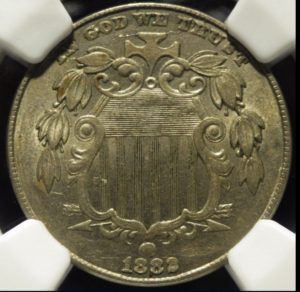Shield Nickel (1866-1883)
Copper-nickel is the alloy of choice for American nickels made today, and the Shield Nickel created after the Civil War is the first five-cent coin to be struck with such a combination. It is also the first to be called a “nickel” since five-cent pieces, which were made of silver, were referred to as half dimes.
Coin hoarding was at a high during the war, leading coins to disappear from circulation. Solutions were offered in the form of fractional currency, one of which was the copper-nickel three-cent piece which proved popular.
Mint Director James Pollock was not a fan of nickel since it was difficult to strike. But the success of the three-cent piece was encouraging and Chief Engraver James Longacre was tasked with designing for a new five-cent piece.
History of the Shield Nickel
Joseph Wharton, an industrialist who owned the largest nickel mine in America, wanted to promote the metal’s use in US coinage. He was highly influential in Congress, with his friends having successfully persuaded for the use of nickel in the three-cent coin.
Pollock prepared a bill for creating a five-cent coin using the same alloy as a three-cent piece. His bill passed on May 16, 1866.
While the bill was still pending in Congress, Longacre came up with possible designs for the new coin. He came up with designs featuring profiles of Washington or Lincoln, but many still took issue with the depiction of an actual person on American money.
So Longacre chose to recycle a previous design he made for the two-cent piece, but with certain modifications made. The design did not please Wharton, the man who desperately wanted nickel to be used in coinage.
Design of the Shield Nickel
The Shield Nickel gets its name from its obverse design: a shield with the cross of the Order of Calatrava. Wreaths flanked the shield on both sides. The reverse design was pretty simple: the numeral 5 circled by 13 stars with 13 vertical stripes between them.
Wharton expressed dislike for the design, likening it to a “tombstone surmounted by a cross and overhung by weeping willows.” It was also controversial since the “stars and bars” motif reminded people of the Confederate States.
Apart from design issues, the new coin was also difficult to make. The rays were blamed for making the coin difficult to strike and as such, they were eliminated in early 1867.
Collecting the Shield Nickel
Only the Philadelphia Mint produced Shield Nickels, with over 100 million struck from the first year it was released until 1883, when it gave way to the Liberty Head Nickel by Charles E. Barber.
The coins produced in 1877 and 1878 are key issues since only Shield Nickel proofs were struck in those years. The business strikes made from 1879 to 1881 are of low mintage.
There are a couple of rarities in during the Shield Nickel’s lifespan. One of the most important is the 1867 Shield Nickel proof, with only 25 pieces struck.
This is one of the most frustrating series to collect because of the low mintage in later years. As such, collectors try to get one each of the Ray and No Ray designs.
